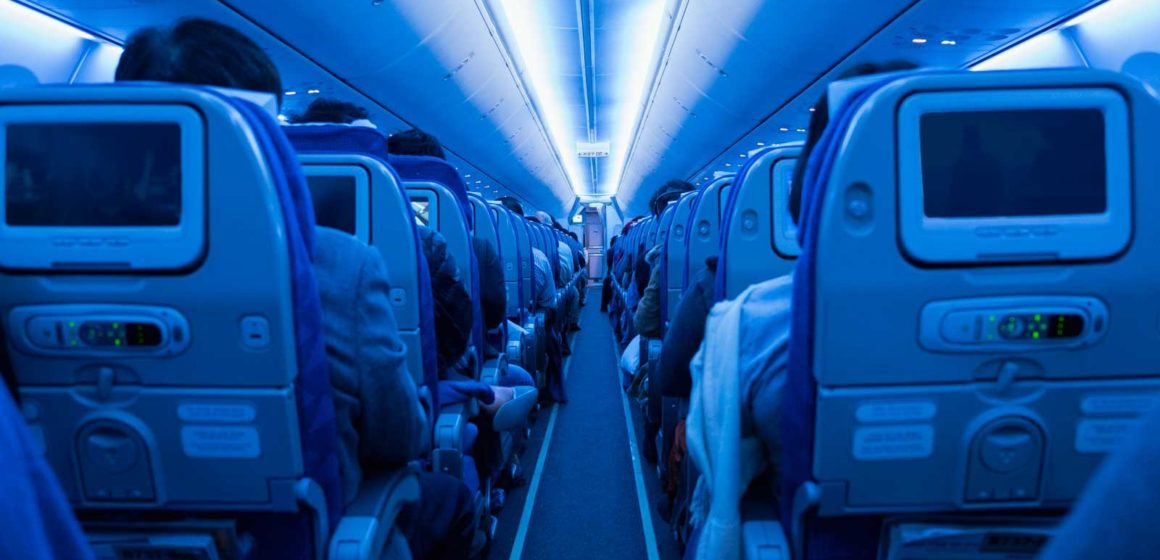Airlines have embraced blue lighting to upgrade the flying experience.
The travel journalist Paula Froelich remembers walking onto her first Virgin America flight and thinking, “What is this, a club?” When the airline launched in the US in 2007, industrial designer Adam Wells decided to avoid the sickly “yellow-green fluorescent lighting” standard on planes in favor of warm, pinkish-purple mood lighting, already a feature in Virgin Atlantic’s first class cabin. The goal was to make the often stressful experience of air travel more welcoming and relaxing — and possibly even pleasant.
Calming, perhaps, but still clubby. Froelich was skeptical of Virgin America’s apparent intention to make airplanes cool, but says that with its comfortable seats and individual screens, “It was just a nice experience. For a lot of people, flying is not a nice experience.”
More than a decade later, Alaska Airlines has acquired Virgin America and set about scrubbing the branding from its airplanes, but the legacy of Virgin’s mood lighting lives on in a number of US airlines, many of which have focused their light color schemes on shades of blue. The color has a number of advantages in this context, says Rama Chorpash, director of the industrial design MFA program at Parsons: Blue is widely liked, associated with blue skies, and gives off appropriately corporate vibes. It makes people feel safer than, say, a red or orange light, which might cause alarm.
Delta introduced ambient lighting in 2013 with its first delivery of Boeing 737-900s, and most of its domestic fleet now features blue and white lighting. JetBlue added blue lighting in 2014, starting with its Airbus A321 planes. United and Southwest use blue lighting on some of their flights, too.
Super-bright blue light can keep people awake, as with the “blue light” emitted by digital screens (which often looks white, with a cool glow) that may be especially effective at suppressing the body’s melatonin production. But blue lighting can be designed to feel soothing. This comes down to its level of brightness, or illumination, which can determine whether a saturated, colorful light feels calming or overwhelming, says Todd Banhazl, the director of photography on Janelle Monáe’s Dirty Computer “emotion picture,” which is full of dramatic lighting moments.
When a colorful light is taken to its maximum brightness, the effect is an assault on the senses; a dimmer light creates a softer, more relaxing space. This is especially true when the light is a fully saturated color (like the red of a traffic light, compared to pale pink bulb), which reduces the eye’s ability to discern contrast and detail.
:no_upscale()/cdn.vox-cdn.com/uploads/chorus_asset/file/16164796/41341305430_19c4dbbb4a_o.jpg)
Before an airline can start devising a color scheme for its cabin lighting, though, it needs airplanes with that capability. The movement toward colorful lighting on airplanes actually represents a larger technological shift, says Zach Honig, editor-at-large at the travel site The Points Guy. As aircrafts have become more advanced, LED cabin lights, which can be programmed to shift in brightness, warmth, and color throughout the flight, have become common on new planes. Aircrafts often stay in use for decades, and so earlier models are being retrofitted with LED lights, as well as new seats and fresh paint jobs.
“Older planes have fluorescent lights with no versatility beyond intensity of brightness,” Honig says. “Now we see the option to offer up to 16 million colors.”
While airlines can use LED lights to spectacular effect — in 2011, Honig took a ride on the Boeing 787 Dreamliner, which was lit up in a rainbow gradient — a disco-like cabin is only one use case for them, and certainly far from the most practical one to an airline.
On long-haul flights, the color temperature can be adjusted to create the experience of a sunrise or sunset, easing passengers in and out of sleep. (United’s 787 Dreamliner does this, for instance.) And whereas an older lighting system might just switch on at full brightness when it’s time to wake up, LED systems can be programmed to fade in over the course of many minutes. Light has a powerful effect on the body, but passengers might not even notice the subtle changes taking place over the course of a flight.
:no_upscale()/cdn.vox-cdn.com/uploads/chorus_asset/file/16164998/GettyImages_140796433.jpg)
“Airlines know how to manipulate your body to sleep,” Froelich says. “They want you to have a better flight experience. A good passenger is an asleep passenger. What they don’t want is someone freaking out or constantly pressing call buttons. That’s not a good experience for anyone.”
Delta has bi-color LED lighting (blue and white) on most of its domestic aircrafts, and it’s transitioning its long-haul international planes to full-spectrum LED lighting that allows a wide range of colors. For the latter, Delta has created unique lighting scenarios for each phase of the flight, from boarding and meal service to cruising at altitude. (As Smithsonian reports, a Boeing jet’s lighting system might be programmed to replicate candlelight during dinner service before moving to a deep blue hue for sleep.)
“Ambient lighting is a small touch that makes a big difference for customers in-flight,” Ekrem Dimbiloglu, Delta’s director of onboard product and customer experience, writes in an email. “We find it provides a more calming and relaxing atmosphere onboard, and it helps customers adapt their eyesight better depending on the time of day and length of flight. This can lead to better rest in-flight, which helps ease the effects of jet lag upon arrival.”
:no_upscale()/cdn.vox-cdn.com/uploads/chorus_asset/file/16165143/GettyImages_157241921.jpg)
This idea isn’t dissimilar to alarm clocks that gradually light up or apps and features designed to mitigate the disruptive effect that light from phone and computer screens have on our sleep. The F.lux app and Apple’s Night Shift option both switch your screen to a warmer hue as the sun goes down.
Airplanes’ use of LED lights isn’t just about customer comfort, or even manipulating passengers into falling asleep, though: They also last longer and use less energy than fluorescents, which saves money over time. (Admittedly, this is a drop in the bucket when it comes to the overall cost of maintaining an aircraft.) As Froelich points out, mood lighting also can help disguise interior wear and tear that might be glaringly evident under unforgiving fluorescent lights.
And, whether explicitly or not, colorful lights establish a brand in consumers’ minds. Virgin America’s famous purple lighting may have relaxed people and made them feel like less of a hot mess — and in doing so, it made the airline look like a groovier, more fun option. Honig says that he was recently on a United flight that had new Premium Plus seats, which are purple, as well as its blue business class section; for part of the flight, the lighting in each area corresponded to the seat color, helping cement the two products in people’s minds.
Lighting is a powerful tool, and airlines have plenty of incentives to use it. As Froelich says: “Nobody but Hooters Air is going to do something just for a club atmosphere.”
Published by vox.com


